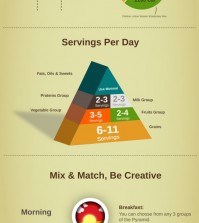- Make It Yourself Lavender Heart-Shaped Bath Bombs!
- 20 Things You Never Knew About “Down There”
- 12 Best Foods For Those Suffering From Arthritis Pain
- 12 Personal Hygiene Mistakes Almost Everyone Makes (Mom Never Told You About #4!)
- 15 Medicinal Plants And Herbs From The Cherokee People
- 12 Mind-Blowing Benefits Of Drinking Coconut Water During Pregnancy
- 12 Outstanding Winter Foods That Won’t Fatten You Up Like A Christmas Turkey
How To Boost Your Child’s Memory
Why memory is so important?
For a child, memory is a vital part of building a good foundation of learning in the home, in the classroom, and beyond both places. A good memory can help your child do better in school, do well on tests, and achieve higher grades. And that’s just the start.
Great, sharp memory skills do not come naturally. It is a skill which kids need to learn and practise often since memory skills develop and improve the more they are put into practice.
If you want your child to reach an optimal level of mastering his or her memory functions, it is important to make sure that your child knows how to flex ‘memory muscles’ on a regular basis.
You can help your child, or children, improve this leading function by adding some memory boosters into their daily lives.
Two important types of memory functions
There are two basic kinds of the working memory function, auditory memory and visual-spatial memory. Auditory memory records are what you are hearing, while visual-spatial captures is what you are seeing.
The difference between the two is that auditory memory isn’t just stored for later use. It needs to be assessed and used immediately, whereas visual-spatial memory can be saved for later use when needed.
If your child is busy with a task, gets interrupted, and forgets that he needs to return to the task at hand, then he might have working memory issues.
Visual-spatial memories help kids to figure out which way the sheet fits onto the bed, and to reason about spatial properties from words like over and under, triangle and rectangle, or small and big.
If the child seems unable to identify the differences, there may be some visual memory issues.
Continue to Page 2
How you can help improve your child’s memory power
A child who develops great memory skills will carry them through school, university education, and into successful career paths in life.
Here are some ways you can help give your child develop the memory foundation necessary for success.
- Encourage your child to share what he is currently learning with you. Make it a challenge to see how much he can remember about the subject and help him to understand anything he is unsure about.
- Create a word list and use it. Make associations between each of the words and different concepts or ideas. The clearer the associations, the easier it will be for your child to remember.
- If your child has a lot of information to absorb and remember, help by breaking it down into smaller bits, and giving it one section at a time to work on. Writing assignments can be handled in a similar way – a few sentences at a time.
- Playing simple card games like sevens, uno, snap, and go fish, are excellent for the working memory. The child has to keep the rules of the game in mind, plus keep his eyes on the cards, and try and remember which cards the other players may still have.
- Play games with your child that stimulates their visual memory. Here are a couple of suggestions: Give your child a magazine page and ask him to tick all the times he sees the word the in the text, or draw a circle around every letter a he notices. Set a time limit of about 2 minutes depending on the length of the text.
- You can do the same thing when out driving in the car. Provide him with a notebook and a pen, and get him to draw two columns, one headed blue or red. Then they can note down every blue car and every red car he sees in the separate columns. You can make the game more interesting by asking that he call out punch buggy blue or punch buggy red before recording the colours. This way your child can learn to be aware of surroundings while you are out which simultaneously works on building memory and visual skills as well as improving concentration.
- Make active reading a part of your child’s life. Encourage him to underline or highlight any parts that make an impression on him, which can help to keep information in the mind long enough to answer questions about it. You can also ask your child to talk out loud and ask questions as he goes along.
- Using flash cards which include pictures and words is another excellent way to stimulate both the auditory and the visual-spatial memory functions. It is all about associations and a young child who is coached in this way will verbally identify something he sees like a train, or a bulldozer, or an apple and an orange, for example.
- It is a well-known fact that our brains are wired to remember certain pieces of music, a particular song, or even a poem which connects us to events and information we have absorbed over time. It works just as well when teaching children the working memory skills. Help your child create a song, a simple jingle, or perhaps a rhyme which can be related to the information he is currently learning. This exercise can help your child’s memory and recall functions improve.
Every child is different, and each child’s level of working memory ability is different. Parents who want to help build a good foundation of working memory for their children need to assess the issues where more attention is necessary, and then plan a course of action which would most benefit the child.
The benefits of the working memory function
- Working memory is like a mental note that keeps track of short-term information, and helps kids hold on to it long enough to use it.
- The visual-spatial memory will help your child reason about terms such as tall and short, bent and straight, round and square etc. For young children these differences can be challenging, and visual memory training will give help to learn about shapes and space.
- Strong working memory skills can improve proficiency in many learning subjects such as reading, maths, and science.
READ ALSO: How To Protect Children From Toxins That Can Cause Brain Damage
Working together
These exercises and coaching can be done at school and at home. Working together with your child, the school facilities, and the teachers, will ensure that your child is given the best possible foundation for optimal working memory skills.
References:


































